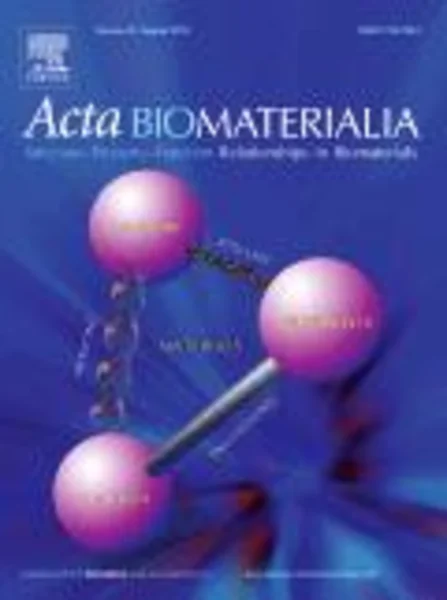-
gene-activated and cell-migration guiding peg matrices based on three dimensional patterning of rgd peptides and dna complexes
جزئیات بیشتر مقاله- تاریخ ارائه: 1392/01/01
- تاریخ انتشار در تی پی بین: 1392/01/01
- تعداد بازدید: 722
- تعداد پرسش و پاسخ ها: 0
- شماره تماس دبیرخانه رویداد: -
essential to the design of genetic bioreactors used in the human body is a consideration of how the properties of biomaterials can combine to envelope, spatially guide, reprogramme by gene transfer, and then release cells. in order to approach this goal, poly(ethylene glycol) (peg) matrices with modulated structural features and defined spatial patterns of bioactive signals have been designed and produced. in particular, within such peg matrices, both an adhesive rgd peptide gradient, to directionally attract nih3t3 cells, and a designed spatial distribution of immobilized poly(ethylenimine) (pei)/dna complexes, to obtain a localized transfection, have been realized. these bioactive biomaterials have been designed bearing in mind that cells following an rgd gradient migrate through the matrix, in which they find the bound dna and become transfected. both cell migration and transfection have been monitored by fluorescence microscopy. results show that this system is able to envelope cells, spatially guide them towards the immobilized gene complexes and locally transfect them. therefore, the system, acting as a genetic bioreactor potentially useful for the regulation of biology at a distance, could be used to directly control cell trafficking and activation in the human body, and has many potential biomedical applications.
مقالات جدیدترین رویدادها
-
استفاده از تحلیل اهمیت-عملکرد در ارائه الگوی مدیریت خلاقیت سازمانی و ارائه راهکار جهت بهبود
-
بررسی تاثیر ارزش وجوه نقد مازاد بر ساختار سرمایه شرکت های پذیرفته شده در بورس اوراق بهادار تهران
-
بررسی تأثیر سطح افشای ریسک بر قرارداد بدهی شرکت های پذیرفته شده در بورس اوراق بهادار تهران
-
بررسی تأثیر رتبه بندی اعتباری مبتنی بر مدل امتیاز بازار نوظهور بر نقد شوندگی سهام با تأکید بر خصوصی سازی شرکت ها
-
تأثیر آمیخته بازاریابی پوشاک ایرانی بر تصویر ذهنی مشتری پوشاک ایرانی (هاکوپیان)
-
معماری سنتی و هنر گرافیک محیطی
-
مطالعه آزمایشگاهی قابلیت تزریق پذیری آبرفت c تهران به منظور تونلسازی
-
جایگاه و وظایف دولت ها در فرایند توسعه فناوری
-
انحلال کنسانتره اسفالریت در حضور آب اکسیژنه
-
ارزش اقتصادی صفات تولید مثل و ماندگاری گاوهای آمیخته استان لرستان
مقالات جدیدترین ژورنال ها
-
مدیریت و بررسی افسردگی دانش آموزان دختر مقطع متوسطه دوم در دروان کرونا در شهرستان دزفول
-
مدیریت و بررسی خرد سیاسی در اندیشه ی فردوسی در ادب ایران
-
واکاوی و مدیریت توصیفی قلمدان(جاکلیدی)ضریح در موزه آستان قدس رضوی
-
بررسی تاثیر خلاقیت، دانش و انگیزه کارکنان بر پیشنهادات نوآورانه کارکنان ( مورد مطالعه: هتل های 3 و 4 ستاره استان کرمان)
-
بررسی تاثیر کیفیت سیستم های اطلاعاتی بر تصمیم گیری موفق در شرکتهای تولیدی استان اصفهان (مورد مطالعه: مدیران شرکتهای تولیدی استان اصفهان)
-
بررسی مقایسه ای بین اعتیاد به فضاهای مجازی و سبک های هویت با رشد اجتماعی دانش آموزان متوسطه دوره دوم
-
بررسی حقوق اقلیت های مذهبی در فقه مذاهب
-
نقش فضای باز، طبیعت و منظر در ارتقا کیفیت آموزشی مدارس (تحلیل کارکردی نظریه بازسازی تمرکز ذهنی در معماری منظر)
-
بررسی رابطه بین سوادرسانه ای، خودمراقبتی و سلامت روان در بین دانش آموزان متوسطه دوم هنرستان های فنی و حرفه ای و کاردانش
-
بررسی عوامل موثر بر قصد خرید لوکس مشتریان با استفاده از روش داده کاوی ( مطالعه موردی حوزه پوشاک )




سوال خود را در مورد این مقاله مطرح نمایید :